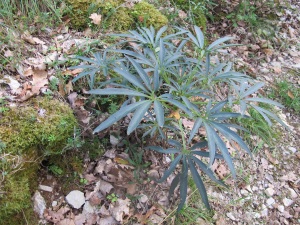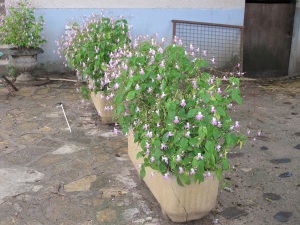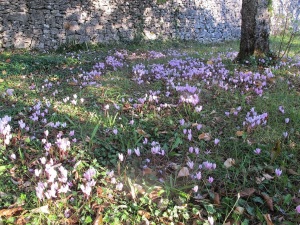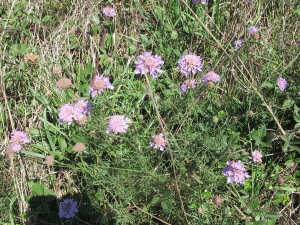On Traveling and Gardening
Being a gardener enhances my enjoyment of almost anything I do – including traveling. I recently went to France to hike a section of the Chemin de Saint Jacques de Compostelle. This is an ancient pilgrim’s trail through France and Spain (where it is called the Camino); it’s a thousand miles long and people have been walking it for over a thousand years.
Part of my joy in this trip was seeing what was growing as we walked along, particularly plants we grow as perennials here in New England but grow there as weeds or wildflowers. I also enjoyed seeing species of plants that are in the same genus (a scientific grouping of closely related plants) that are different species, but similar to ours. And seeing how things grow there informs me about what specific plants need.
Everywhere we walked we saw the light purple or heather-blue flowers of pincushion flower (Scabiosa spp.). It grew in fields, competing with grasses, and along roadsides. The soil in the part of France where we hiked was full of limestone rock, so it must be somewhat alkaline. I’ve grown this perennial, but it has never thrived for me, dying out after a year or two. I think if I plant it again, I will add some limestone to the soil. A cup of limestone worked into the soil around a trio of plants should help.
Jewelweed or touch-me-not (Impatiens capensis) is a tall weed that thrives in shade and produces seed pods that, when ripe, can propel seeds several feet when touched. Along my hike I saw a relative, probably Impatiens glandulifera, that not only appeared along the trail but also in gardens. This one is shorter than ours, two feet tall or less, and has nice pinkish flowers. Weed or garden plant? I saw it in planters, so I guess it is considered a garden plant there.
Speaking of weeds, I saw a little purple loosestrife in France, but never in the huge swaths have I seen it wetlands here. I saw a few plants alongside a disturbed area by a man-made lake. Everything I have read about this invasive here has told me that in Europe, where purple loosestrife came from, there are many natural insect predators to keep it under control; here are there are no natural predators. The plants I did see were much smaller than what I have seen here.
I saw large swaths of a bright yellow crocus, a large one that seemed to naturalize and spread nicely. I asked a local about it, he could only tell me that it was a type of crocus, but no species or cultivar name. I’ve grown fall crocus here, a beautiful purple-blue one that is the species that produces saffron (Crocus sativus). Unfortunately, it takes 7,000 blossoms to produce 3 ounces of saffron and mine, instead of naturalizing, have tended to disappear. Not sure if the squirrels are into saffron, or if the conditions where I planted them are not quite right.
Cyclamen is often sold as a very satisfactory houseplant here, but can also be grown as a fall-blooming outdoor plant. In France I saw huge patches of it blooming, mainly in shady places near homes, which made me think it was planted but I did see some growing in the wild, too. The variety I have grown is a species called Cyclamen neapolitanum. It has survived over the years, but rarely blooms for me, or if it does, it may escape my notice – it blooms just when my maples drop their leaves.
A plant that delighted and surprised me along the trail was stinking hellebore” (Helleborus foetidus). Hellebores are among my favorite flowers in early spring, though of a different species than the French one I saw – I grow lots of the kind called Lenten rose (Helleborus orientalis). The Lenten rose is hardy to zone 4 and has been hybridized in recent years to produce blossoms ranging from deep purple to peach and pink. It grows in shade or partial shade and has glossy evergreen leaves. The stinking hellebore has greenish flowers that are malodorous, hence the name. It is hardy here to zone 6, though I have grown it successfully – though I rarely get any flowers.
Hawthorns (Crataegus spp.) are very common France, both in hedgerows and in the wild. I have a green hawthorn (Crataegus viridis), a species commonly used as a street tree for its toughness, medium size, and red berries in winter. Mine is a variety called ‘Winter King’ which is commonly sold. There I saw numerous English Hawthorn (Crataegus laevigata). Interestingly, most had no berries, even though it was the right season for them. Birds don’t seem to like the berries of ‘Winter King”, but I suppose the English hawthorn berries might be appealing to French birds. Or was it revenge on the English for the 100 Years War?
There were so many other interesting plants growing in France I can’t describe them all. I saw purple kale grown decoratively, and sage grown in quantity for the color of its leaves. Fall anemones were common in gardens, and of course the French love their roses. And being on vacation, I always took time to smell the roses. So when you go on vacation, I hope you’ll take note of the plants and e-mail me if you see something wonderful.
Henry can be reached by e-mail at henry.homeyer@comcast.net or at P.O. Box 364, Cornish Flat, NH 03746. Please include a self-addressed stamped envelope if asking a question by regular mail.






